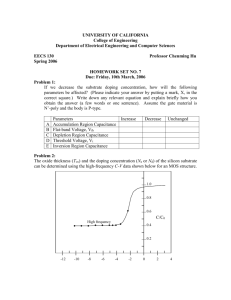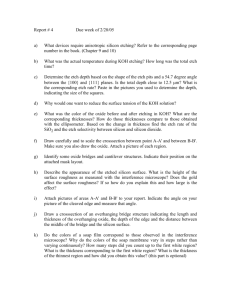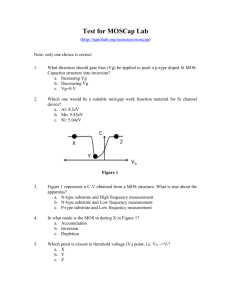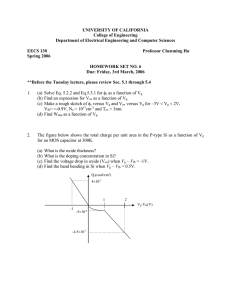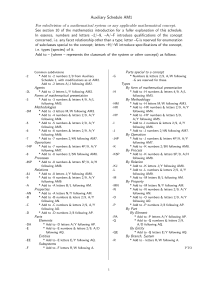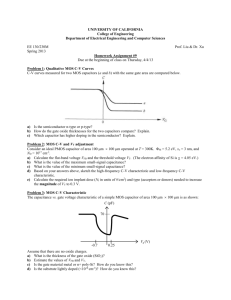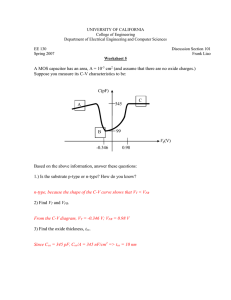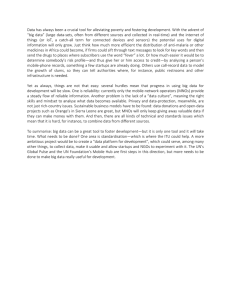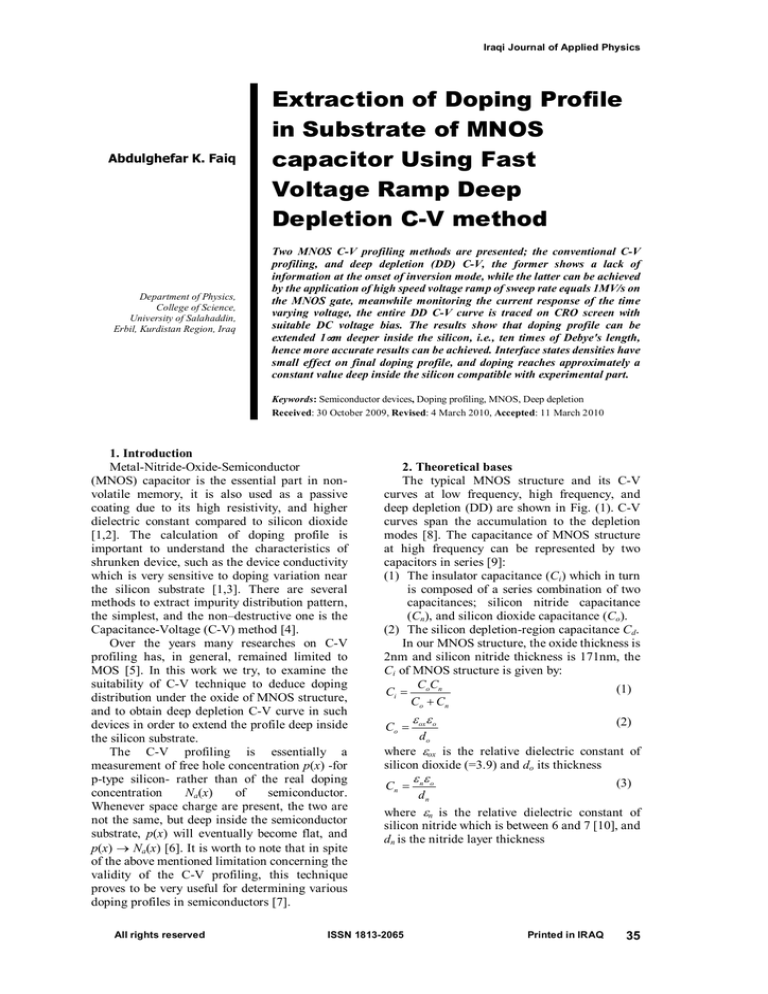
Iraqi Journal of Applied Physics
Abdulghefar K. Faiq
Department of Physics,
College of Science,
University of Salahaddin,
Erbil, Kurdistan Region, Iraq
Extraction of Doping Profile
in Substrate of MNOS
capacitor Using Fast
Voltage Ramp Deep
Depletion C-V method
Two MNOS C-V profiling methods are presented; the conventional C-V
profiling, and deep depletion (DD) C-V, the former shows a lack of
information at the onset of inversion mode, while the latter can be achieved
by the application of high speed voltage ramp of sweep rate equals 1MV/s on
the MNOS gate, meanwhile monitoring the current response of the time
varying voltage, the entire DD C-V curve is traced on CRO screen with
suitable DC voltage bias. The results show that doping profile can be
extended 1µm deeper inside the silicon, i.e., ten times of Debye's length,
hence more accurate results can be achieved. Interface states densities have
small effect on final doping profile, and doping reaches approximately a
constant value deep inside the silicon compatible with experimental part.
Keywords: Semiconductor devices, Doping profiling, MNOS, Deep depletion
Received: 30 October 2009, Revised: 4 March 2010, Accepted: 11 March 2010
1. Introduction
Metal-Nitride-Oxide-Semiconductor
(MNOS) capacitor is the essential part in nonvolatile memory, it is also used as a passive
coating due to its high resistivity, and higher
dielectric constant compared to silicon dioxide
[1,2]. The calculation of doping profile is
important to understand the characteristics of
shrunken device, such as the device conductivity
which is very sensitive to doping variation near
the silicon substrate [1,3]. There are several
methods to extract impurity distribution pattern,
the simplest, and the non–destructive one is the
Capacitance-Voltage (C-V) method [4].
Over the years many researches on C-V
profiling has, in general, remained limited to
MOS [5]. In this work we try, to examine the
suitability of C-V technique to deduce doping
distribution under the oxide of MNOS structure,
and to obtain deep depletion C-V curve in such
devices in order to extend the profile deep inside
the silicon substrate.
The C-V profiling is essentially a
measurement of free hole concentration p(x) -for
p-type silicon- rather than of the real doping
concentration
Na(x)
of
semiconductor.
Whenever space charge are present, the two are
not the same, but deep inside the semiconductor
substrate, p(x) will eventually become flat, and
p(x) 0 Na(x) [6]. It is worth to note that in spite
of the above mentioned limitation concerning the
validity of the C-V profiling, this technique
proves to be very useful for determining various
doping profiles in semiconductors [7].
All rights reserved
2. Theoretical bases
The typical MNOS structure and its C-V
curves at low frequency, high frequency, and
deep depletion (DD) are shown in Fig. (1). C-V
curves span the accumulation to the depletion
modes [8]. The capacitance of MNOS structure
at high frequency can be represented by two
capacitors in series [9]:
(1) The insulator capacitance (Ci ) which in turn
is composed of a series combination of two
capacitances; silicon nitride capacitance
(Cn), and silicon dioxide capacitance (Co).
(2) The silicon depletion-region capacitance Cd.
In our MNOS structure, the oxide thickness is
2nm and silicon nitride thickness is 171nm, the
Ci of MNOS structure is given by:
CC
(1)
Ci = o n
Co + Cn
Co =
(2)
ox o
do
where ox is the relative dielectric constant of
silicon dioxide (=3.9) and do its thickness
Cn =
(3)
n o
dn
where n is the relative dielectric constant of
silicon nitride which is between 6 and 7 [10], and
dn is the nitride layer thickness
ISSN 1813-2065
Printed in IRAQ
35
IJAP Vol. (6), No. (1), January 2010
This equation shows that the doping
concentration N(w) can be calculated from the
slope of (1/Cm2) vs. V curve. The above relation
is considered to be the free carrier concentration,
more specifically, when the true hole
concentration p(x) varies by an appreciable
fraction over a distance less than an extrinsic
Debye length:
1
LD = (
(a)
kT 2
)
q p
(9)
s o
2
where q is the electron charge, and the measured
apparent hole concentration is an average p(x)
taken over a distance of this order [6]
Rewriting Eq. (8), replacing w with x, and
N(w) with p(x) to mathematically relate the
measured capacitance Cm of the MNOS structure
and the majority carrier distribution p(x):
1
)
Cm2
]
dV
d(
p ( x) = 2[q
(b)
Fig. (1) (a) ideal MNOS structure, (b) ideal HF, LF
and deep depletion (DD) C-V curves
In our case, the nitride layer thickness is
about 50 times greater than silicon dioxide layer
thickness; we can approximate Eq. (1) to:
(4)
Ci = Cn
Hence, the measured MNOS capacitance
(Cm) is equal to:
CC
(5)
Cm = n d
Cn + Cd
C + Cn
(6)
Cd = m
Cn Cm
where Cd is the depletion capacitance and given
by:
o
(7)
w
where w is the depletion width and s is silicon
relative dielectric constant (=11.9)
The depletion capacitance changes with
voltage from a maximum at which the total
capacitance is equal to Cn, toward a minimum of
Cmin when the depletion depth is maximum wm,
and the capacitance curve reach its minimum
Cmin, Fig. (1b). We can calculate Cdmin from the
C-V curve at Cmin by substituting the value of
Cmin in Eq. (6) and calculating Cd equals to Cdmin
[11].
The depletion approximation method of
doping profile is [7]:
1
d( 2 )
3
Cm
Cm
dC
]1=
( m ) 1 (8)
N ( w) = 2[q s o
dV
q o s dV
Cd =
36
s
s o
1
(10)
Following the derivation in [12], by
introducing the effect of stretch out of C-V curve
caused by interface states, the interface states
corrected hole profile p'(x) is obtained:
1
C LF
d( 2 )
1
Cn
Cm 1
(11)
)[q s o
]
p' ( x) = 2(
C HF
dV
1
Cn
Kennedy et al. [13] developed a simple
mathematical formula which expresses the
doping as a function of free carrier concentration
in one dimension, following their derivation but
for holes rather than electrons because electrons
were their majority carriers:
The electric current within this material due
to both drift and diffusion of majority holes is
given by:
dp
d1
(12)
J p = qD p
qpµ p
dx
dx
where Jp is hole current density, Dp is holes
diffusion constant, µp is holes mobility, and 1 is
the electric potential
Einstein relation states that:
Dp
µp
=
kT
q
(13)
An electric current of zero implies that the
diffusion and drift terms in Eq. (12) are of equal
magnitude, but in the opposite direction; hence,
from equations (12) and (13), an electric field
E(x) is obtained:
d1
kT 1 dp( x)
(13)
E ( x) =
=
dx
q p( x) dx
where k is Boltzmann’s constant, and T is
absolute temperature
Equation (14) establishes the electric field
distribution necessary to maintain an electric
current of zero in p-type material containing
local variations of holes density. Assuming
© 2010 Iraqi Society for Alternative and Renewable Energy Sources and Techniques (I.S.A.R.E.S.T.)
Iraqi Journal of Applied Physics
extrinsic semiconductor material (the minority
carrier density has negligible influence upon the
structure under consideration), we have from
Poisson’s equation
q
dE
(15)
=
[ p ( x) N a ( x)]
dx
s o
The divergence of the electric field, in Eq.
(14) is determined by both the impurity atom
distribution Na(x) and the majority carrier
distribution p(x), by combining equations (14)
and (15) we obtain:
kT d
1 dp ( x)
q
{
}=
[ N a ( x) p ( x)] (16)
q dx p ( x) dx
s o
and therefore
kT d
1 dp ( x) (17)
N a ( x) = p ( x) ( s o )( ) [
]
q
q dx p ( x) dx
Equation (17) rigorously relates the desired
impurity atom distribution Na(x) to the measured
majority carrier distribution p(x). In order to
extend doping profile deeper inside the silicon,
we must obtain deep depletion DD C-V curve.
When the gate bias is swept from accumulation
into the inversion region too fast for minority
carrier (electrons) to follow, the charge neutrality
must be satisfied by the ionized acceptor alone,
therefore, the depletion width become broader
than that in thermal equilibrium, and the
capacitance decreases below its thermal
equilibrium saturation value (Cinv). Such a nonequilibrium condition is called deep depletion
[14]. Usually deep depletion can be achieved by
increasing the voltage bias sweep rate in the C-V
measurement (high enough that not allow the
creation of minority electrons).
3. Material and experimental technique
The measured device is MNOS structure. ptype (100) silicon wafer of resistivity 5-10 2.cm
is used with approximately doping of about
2x1015cm-3. Native SiO2 layer of thickness ~2nm
is formed, Si3N4 layer is deposited by using of
Low Pressure Chemical Vapor Deposition
(LPCVD) method, the thickness is 171nm
measured by ellipsometry. Aluminum is used as
front and back contacts. The front contact is
deposited at low pressure of 5x10-6 mbar across
suitable mask of area 0.01cm2 using Edward 306
A coating system. The back contact is deposited
without mask.
Two methods of C-V measurements are
performed:
(1) The conventional C-V measurement is
performed
on
FLUKE
PM
6306
programmable Automatic RLC Meter. The
voltage sweep bias is supplied by Keithly
Pico-Ammeter/DC Voltage Source Model
6487. Electrical contacts are made by
pressing the metallic gate using a spring clip
arrangement.
All rights reserved
(2) The DD C-V measurement is achieved by
the application of high speed saw tooth
voltage on MNOS sample provided by
TEKTRONIX FG 502-11MHz Function
Generator. The DD C-V curve is traced on
the screen of TEKTRONIX (1GHz) TDS
5104 Digital Phosphor Oscilloscope, which
has the ability of saving and exporting the
wave form to MATLAB for mathematical
operations. The voltage bias is supplied by
the same previous Kiethly DC voltage
source for returning flat-band voltage to the
origin of the scope's screen. Whole
measurements are performed in dark at room
temperature 300K. A full description of this
circuit with an example of C-V curve as
shown on the CRO screen is given in the
appendix.
4. MATLAB (6.5) Algorithm
The following MATLAB Algorithm is
designed for the determination of doping profile
5. Results and Discussion
Figure (2) shows the 1MHz C-V curve of
MNOS sample, in which the scan is initiated at
voltage of -20V in accumulation mode towards
the inversion with sweep rate of =3V/s.
Nitride's capacitance per unit area Cn is
calculated from the accumulation and its equal to
2.375x10-8F/cm2. The flat-band voltage (VFB) is
ISSN 1813-2065
Printed in IRAQ
37
IJAP Vol. (6), No. (1), January 2010
standard LF C-V curve. The shape of C-V curve,
whether it takes HF or LF shape, depends on
minority carriers lifetime [9]. When the life time
is long, the C-V curve takes LF shape in very
low frequencies, as low as possible; to the degree
the minority carriers could follow the ac signal,
i.e., quasi-static. But as we will show later, it is
obvious that minority carrier life time is so small
that we have LF C-V curve even at 10 kHz.
also calculated and it is equal to -16.8V using
0.9Cacc rule. The rule which states that: flat band
capacitance CFB is equal to 90% of accumulation
capacitance Cn [15].
5.1 Deep Depletion
It is necessary to extend the profile deeper
inside the silicon substrate in order to get more
accurate information about doping concentration
change with depth, and thus for: first, the
conventional doping profile is limited to small
depths inside the silicon - that is, calculated in
our case as 0.6µm, and valuable information
about the exact doping can not be achieved in
such small depths. Second, the change in
majority carriers, actually measured by C-V
profiling, limits the resolution of the differential
capacitance method to distances comparable to
the local extrinsic Debye length [6,19]. We
calculate LD using Eq. (9) for NA=2x1015cm-3, as
0.09µm.
Figure (4) shows LF (10 kHz), HF (1MHz),
and DD C-V curves. The DD C-V curve is
obtained by using the circuit given in the
appendix. The transient C-V curve can be
achieved directly by measuring MNOS current
response to a very fast voltage ramp of sweep
rate of 1MV/s, this current response is
proportional to the differential capacitance and
carries information on the doping density [8].
Thus, as it was mentioned previously, the large
sweep rate ( =106V/s) indicates that the minority
carrier life time is very small [12].
Fig. (2) C-V curve of MNOS sample under the
application of voltage ramp of sweep rate (3V/s)
from accumulation (-ve voltages) to deep inversion
(+ve voltages), and then in the reverse direction
The curve which shows an increase of
capacitance in strong inversion as a result of
formation of certain amount of interface state
tarps because of the large DC field stress
~1.2x106V/cm [16,17], then we record a constant
capacitance till the end of the scan(+40V), like
an ideal C-V curve. In the reverse direction we
notice two effects: the first one is another
increase of capacitance as a result of creation of
interface state traps; the second one is that we get
the flat–band condition at +7V, this results in a
memory window of 23.8V, which indicates that
electrons are tunneled across the silicon dioxide
and then trapped in the silicon nitride layer [18].
Figure (3) is the conventional C-V curves of
MNOS capacitors at frequencies (10 kHz, 100
kHz and 1 MHz), the DC sweep rate is the same
for all frequencies =3V/s.
300
Capacitance (pF)
200
100
10KHz
100KHz
1MHz
0
-25
-20
-15
-10
Voltage (V)
-5
0
Fig. (3) Three C-V curves at 10 kHz, 100 kHz and
1MHz. The sweep rate is the same (3V/s)
The 10kHz curve shows an increase in the
inversion capacitance toward Cn like the case of
38
Fig. (4) Three MNOS C-V curves 10 kHz, 1 MHz and
DD, the sweep rate for the first two curves is the
same (3V/s), while for DD curve it is 1MV/s
5.2 Calculation of Doping Profile
The majority hole profile from the surface
toward the bulk of p-type silicon substrate is
calculated by Eq. (10) using conventional C-V,
© 2010 Iraqi Society for Alternative and Renewable Energy Sources and Techniques (I.S.A.R.E.S.T.)
Iraqi Journal of Applied Physics
and DD curves as its shown in Fig. (5). DD C-V
profile provides additional 1µm deeper inside the
silicon compared to the conventional differential
C-V profile. At onset of inversion, the
calculation of hole profile is not accurate [12],
that is why we see a rapid increase of hole
density.
seemed to be an average of charge density
profile. The interface state correction terminates
at about 0.6µm because the LF C-V
measurement's lowest capacitance is 1.096*10-8
F/cm2 corresponds to depletion width of 0.6µm
by using equations (5) and (6), while the lowest
DD capacitance is at 0.52x10-8F/cm2 corresponds
to depletion width of 1.5µm, that is why we
cannot extend the interface state correction of
hole profile p'(x) to distances greater than 0.6µm.
Fig (5) Hole profile using (1MHz) equilibrium and
deep depletion (DD) method
Figure (6) shows the comparison between the
interface state density correction of hole profile
p'(x) using Eq. (11) with hole profile p(x). The
two are approximately of the same value,
therefore we can ignore the effect of interface
state in our calculations. The graph shows a
decrease in hole density when we go deeper
inside the silicon which is similar to the change
in doping density calculated from Eq. (17), as it
is shown in Fig. (7).
Fig. (6) Hole profile p(x) and interface states
corrected hole profile p'(x)
In this curve p(x), p'(x) and the doping
densities Na(x) reach approximately a constant
value of about 2x1015cm-3. The reason behind the
change in doping at the surface is that thermal
oxidation of silicon moves dopant ions from their
equilibrium positions [12]. Moreover, the
thermal deposition of the Si3N4 layer may cause
additional rearrangement of the dopant ions.
Deeper inside the silicon, the hole density is
All rights reserved
Fig. (7) Doping profile Na(x), and hole profile p(x)
6. Conclusions
C-V technique gives suitable information
about impurity charge distribution near and the
surface of silicon substrate of MNOS device. A
deep depletion DD MNOS C-V curve was
obtained by the application of high speed voltage
ramp of sweep rate of (106V/s), and the current
response of such voltage ramp is monitored. It
was found that interface states densities have
negligible effect on the calculation of doping
profile. Doping profile decrease with going deep
into the silicon bulk reaching approximately a
constant value of 2x1015cm-3.
References
[1] J.R. Elmiger and M. Kunst, Appl. Phys.
Lett., 69(4) (1996) 517-519.
[2] T.P. Ma, IEEE Trans. Electron Devices,
45(3) (1998) 680-690.
[3] J. Heo et al., Mater. Sci. and Eng. B, 124125 (2005) 301-304.
[4] A. Pirovano et al., IEEE Trans. Electron
Devices, 48(4) (2001) 750-757.
[5] F. Recart and A. Cuevas, IEEE Trans.
Electron Devices, 53(3) (2006) 442-448.
[6] H. Kroemer and W.Y. Chien, Solid State
Electron., 24 (1981) 655-660.
[7] A.F. Yaremchuk, Appl. Phys. A, 73 (2001)
503-509.
[8] R.C. Hughes, R. Bastasz and W.P. Ellis,
Appl. Surf. Sci., 115 (1997) 74-79.
[9] R.F. Pierret, "Semiconductor Device
Fundamentals",
Addison-Wesley
ISSN 1813-2065
Printed in IRAQ
39
IJAP Vol. (6), No. (1), January 2010
Publishing Co., Inc. (USA) (1996), Ch. 16,
587-591, 595-598.
[10] S.M. Sze, "VLSI Technology", McGrawHill Book Co. (Singapore) (1988), Ch. 6,
259-263.
[11] S.M. Sze and K.N. Kowk, "Physics of
Semiconductor Devices", John-Wiley &
Sons, Inc. (NJ, USA) (2007), Ch. 4, 202209.
[12] E.H. Nicollian and J.R. Brews, "MOS
Metal Oxide Semiconductor Physics and
Technology", John-Wiley & Sons, Inc. (NJ,
USA) (2003) Ch. 9, 387-390, 375-380, Ch.
14, 721-731.
[13] D.P. Kennedy and R.R. O'Brien, IBM J. Res.
Develop., (1968) 212-214.
[14] C.Y. Liu, B.Y. Chen and T.Y. Tseng, J.
Appl. Phys., 95(10) (2004) 5602-5607.
[15] D.K. Schroder, "Semiconductor Material
and Device Characterization", John-Wiley
& Sons, Inc. (NJ, USA) (2006), Ch. 6, 328.
[16] S. Minami and Y. Kamigaki, IEEE Trans.
Electron. Devices, 40(11) (1993) 2011-2017.
[17] C. Bae, "GaN-dielectric interface formation
for gate dielectrics and passivation layers
using remote plasma processing", Ph.D.
Thesis, North Carolina State University,
(USA) (2003).
[18] K. Ohnishi, and K. Miura, Electron. and
Commun. in Japan, part 2, 75(4) (1992) 5259.
[19] C.L. Wilson, IEEE Trans. Electron. Devices,
27(12) (1980) 2262-2267.
Appendix
Fast ramp (1MV/s) C-V tracer circuit with a snapshot
of the CRO screen
dv =constant
dt
The capacitance C = dq = dq dt = i
dv dt dv
The sweep rate
=
(a1)
(a2)
Where i is the instantaneous current, hence the i-v
curve shown on the CRO screen can be converted
into C-V curve using Eq. (a2)
_____________________________________________________________________________________
40
© 2010 Iraqi Society for Alternative and Renewable Energy Sources and Techniques (I.S.A.R.E.S.T.)

